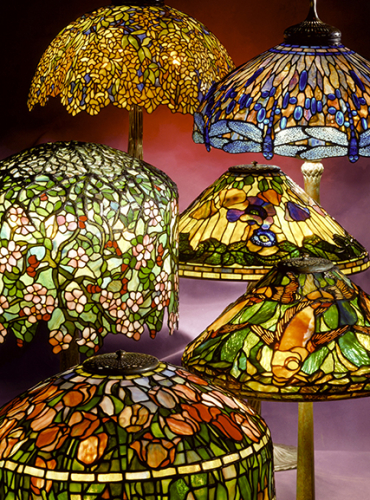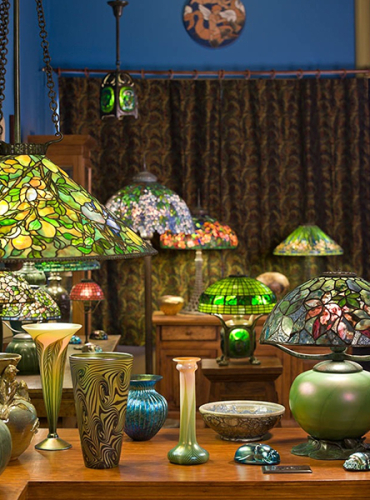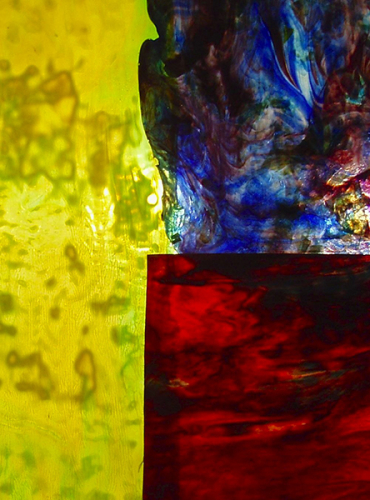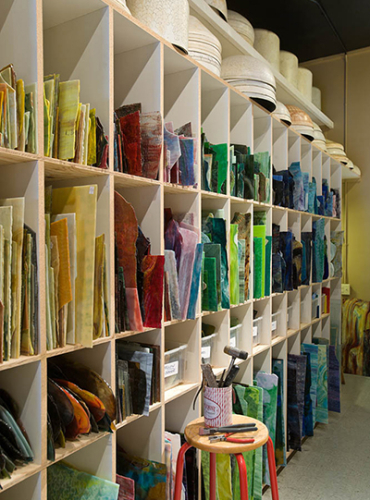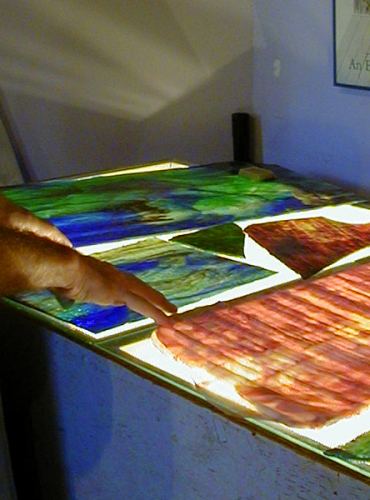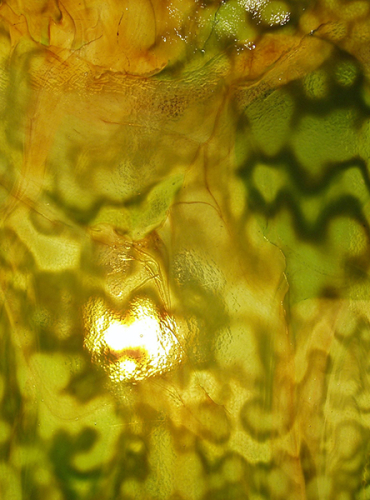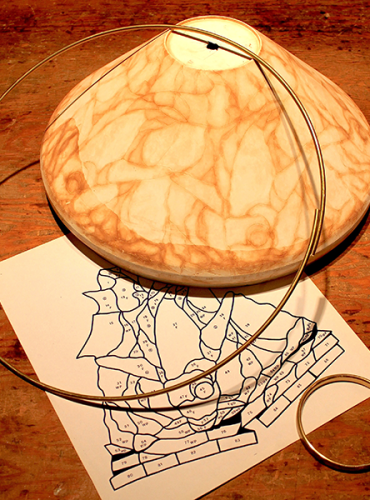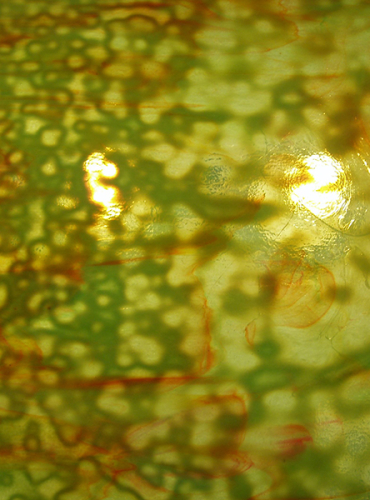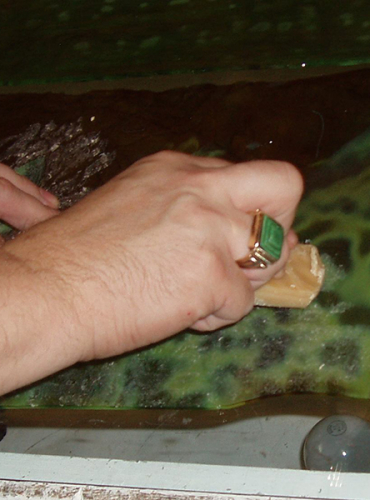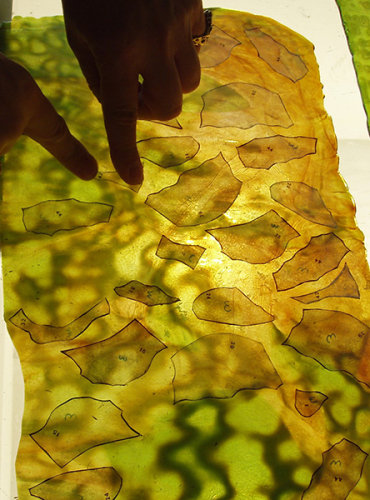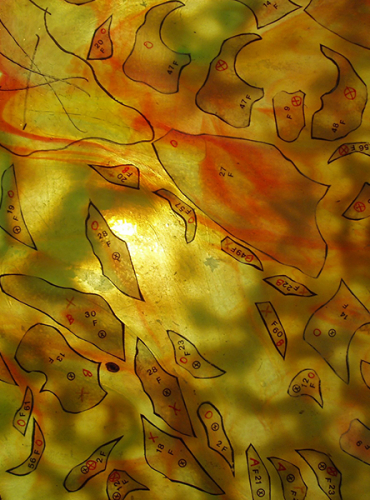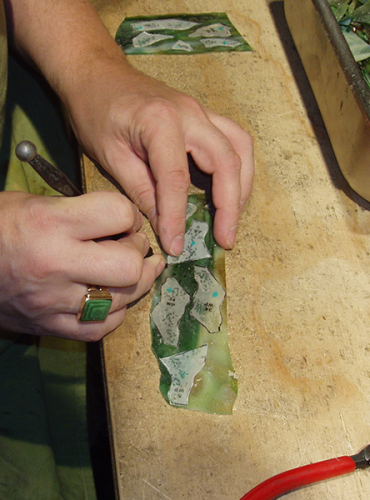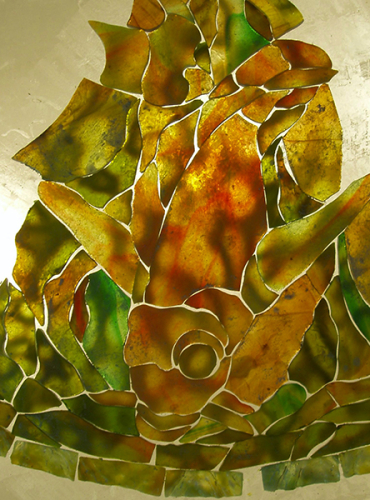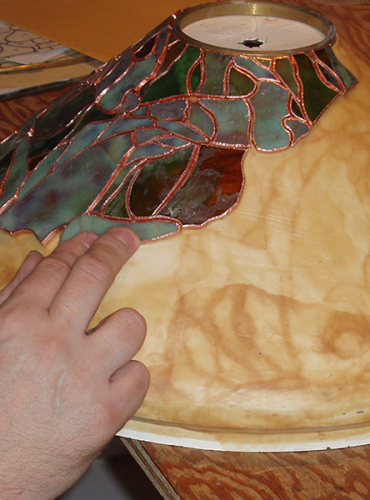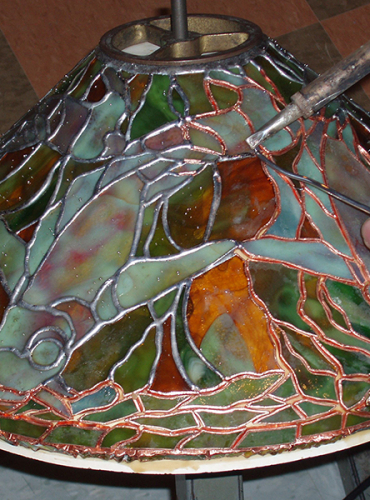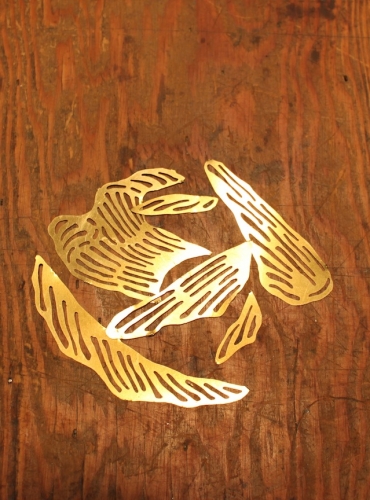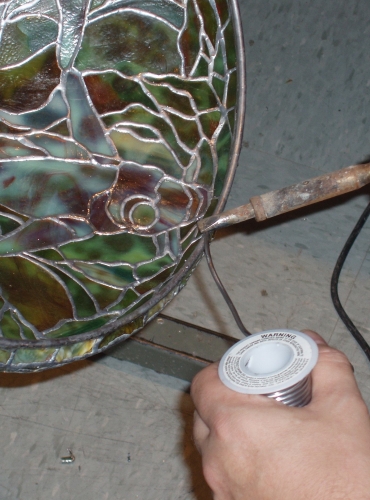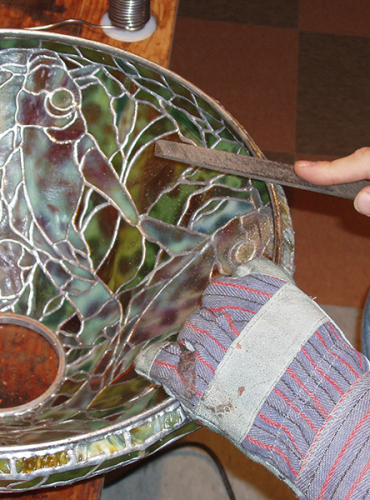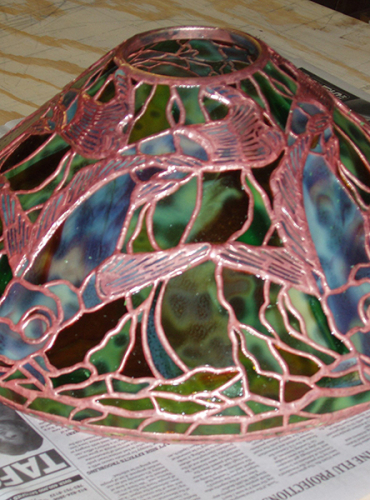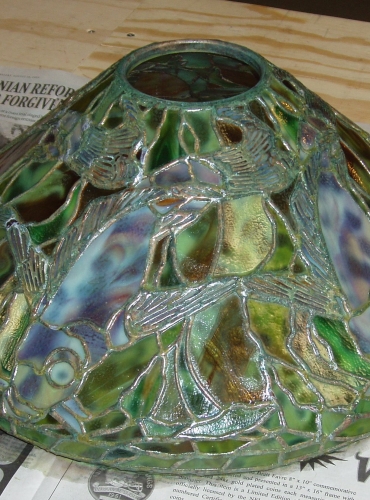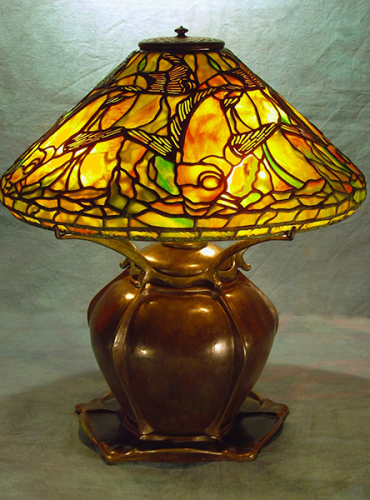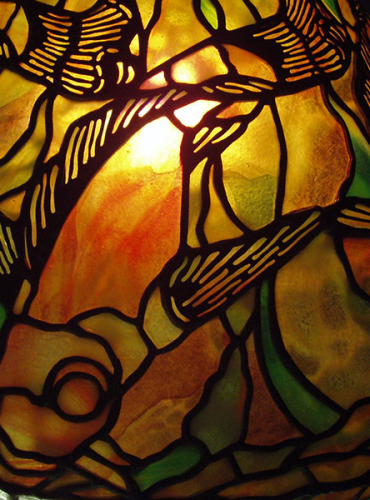“Infinite endless labor makes the masterpiece”
-Louis Comfort Tiffany
At Century Studios, reproductions of Tiffany lamps are made using the methods and techniques employed by Tiffany Studios at the beginning of the 20th Century. Floral lamp patterns were created and executed by a team of women at Tiffany Studios under the direct supervision of Louis Comfort Tiffany himself, while the simpler geometric shades, considered more masculine, were created by men at the Studios’ foundry location.
Each lamp created at Century Studios is completely crafted by hand. Shade patterns range from small geometric designs to large intricate floral lamps, which can have as many as 2000 individual pieces of glass. Production time to complete a single shade will vary from 30 to 300 hours, depending on the complexity of the design. Century Studios lamps are created with the same care and attention to detail as the Tiffany originals and are sure to become treasured heirlooms to be passed down to future generations.
When Tiffany Studios closed in 1933 almost all of the production materials used to create their lamps were discarded. Modern glass artists must therefore glean information from existing works which were created by the studio. Designs are taken from original lamps, and turned into working patterns for creating a reproduction. Many Tiffany shade patterns have sectional repeats which will create the full 360° design. There may be three repeats of a section, or possibly two, four, six, nine, even twelve repeats for a full lamp shade. Some Tiffany designs have no repeats.
Measurements are taken and a form is created which is the same size and shape as the original Tiffany shade. Tiffany Studios created prospective new forms in plaster. Once a shape and pattern were approved, the lamp form was turned in wood. Wooden forms are heavy, problematic to store, and because of their weight, are difficult to work with. A number of Tiffany-accurate forms made of fiberglass are available commercially to today’s lamp artist. At Century Studios, we also create our own forms.
Once the flat pattern and three dimensional form are created, the pattern is drawn onto the form to check the accuracy and glass selection can begin.
Over the last 30 years, there have been a handful of American glass manufacturers who have created excellent hand rolled Tiffany reproduction sheet glass. Tiffany Studios manufactured its own glass and also used glass created by various makers such as the Kokomo Opalescent Glass Company, which is still in business. American hand-rolled sheet glass differs from European glass in color, texture and transparency. While most European glass is referred to as Cathedral (transparent), American made reproduction glass is usually Opalescent (stops the light and is not completely transparent).
Tiffany Studios used many kinds of opalescent glasses in their lamps; flat, textured, transparent, ring mottle, streaky, fracture, confetti, and drapery are all descriptions of glasses used to create specific effects in the shades. The best hand rolled, opalescent glasses can have as many as five distinct colors in one sheet.
The following photos will show the construction of a lamp from start to finish. The most important aspect of reproducing a Tiffany lamp is the selection and layout of the glass. This is the stage where the artistry of a Tiffany pattern will come to life. At this stage, the artist is creating. After this step, the glass artist is constructing.
When beginning a project, the pattern is studied and appropriate glass is chosen at a light table. Since the appearance of opalescent glass will vary when viewed with different light sources, the light source of the light table must be the same as that used to illuminate the completed lamp. For example, some purple glass will look purple in daylight, but will appear brown in incandescent light. Modern LED bulbs will also change the appearance of a sheet of glass. Clear and frosted lightbulbs must be considered, as frosted will flatten the look of some glasses while clear bulbs will provide more sparkle.
Each pattern piece is positioned on the sheet of glass and cut by hand to fit the pattern. Original Tiffany pattern pieces were constructed from thin sheets of copper and cut around the outside edge. We use transparent mylar patterns to lay out the pieces. The mylar patterns are held to the glass using a “tacky wax” that has been rubbed over the surface of the glass. Some artists prefer to trace around each pattern piece and cut on the drawn lines.
The glass surface is scored around the pattern piece with a glass cutter, and will break along the score. Other tools used to help cut the glass pieces to size include a grozing plier, running pliers and nippers.
The cut pieces are laid out on a piece of glass and examined on the light table. This flat layout is studied and adjusted until all the pieces of glass are cut and fit and the artist is satisfied that the coloration is correct.
A thin copper foil is then wrapped around the outside edge of each piece in the lamp. This copper foil is the surface which the solder will adhere to in the next step, and this will form the structure of the lamp. Tiffany Studios used sheet copper which was spread with a thin layer of wax as an adhesive. Since the mid-1970’s there has been copper foil with an adhesive on the back available to todays glass artist.
Once all the pieces of glass are foiled by hand (our most complex shade designs consist of over 2000 individual pieces), everything is transferred onto the fiberglass form. The workers at Tiffany Studios would often have to hold the pieces onto their wooden forms using steel pins until they were tack soldered in place. With a fiberglass form, the pieces are held in place with wax, and once everything is set on the form, the soldering begins.
Using a lead/tin solder and a soldering iron, the pieces of glass are connected together to form a single lamp shade. The “lead line” between the pieces is usually soldered so that there will be a uniform slight bead to the line. If too little solder is used, the lead line will look concave and the edges of the foil will peel back during cleaning. A proper bead takes many hours of practice and patience to achieve.
Tiffany shades have sturdy brass rings set into the top of each shade. These are sized to mate with different sized wheels. These wheels are screwed onto the lamp bases or chandelier fixtures and will support the shade. The ring is leveled and soldered in place at the top of the shade.
Once the outside of the shade is soldered and the upper ring is installed, the fiberglass form is warmed, the wax melts and the shade is removed from the form. Shades which have an undercut are removed in two pieces along a lead line that has not been soldered together. The lower portion of the shade is then reattached to the upper. Soldering continues on the inside of the shade until every lead line is finished. Larger shades will be reinforced with copper wires soldered in place inside the shade, conforming to the path of the lead lines. These reinforcing wires are not seen when the lamp is finished, but provide additional stability to larger pieces.
For shades with a flat lower edge, a brass rim is soldered into place at the bottom of the shade. The rim provides strength and stability to the shade and gives each shade a visually even lower edge. Shades with irregular lower edges will have a half round heavy copper wire soldered in place, following the undulating contours of the shade.
Once the soldering is finished, the shade ring and rim are filed for smoothness. The shade is then cleaned, and ready for patina.
Tiffany Studios offered a variety of patinations on their lamps. The patina on a lamp shade colors the lead lines so that the shade will match the metal finish on the base or chandelier fixture.
The standard verdigris (green/brown with red highlights) patina on a Tiffany shade is achieved by copper plating the lamp shade. The copper plate adheres to the lead-tin solder and not the glass. The lead lines are then aged in a multi-step chemical process which first darkens the copper, then brings up the green color.
Once the patination is complete, the patina on the lead lines needs to be sealed. The surface of the entire shade is covered with a thin lacquer and the shade can then be waxed to further tone the patina if desired. Tiffany Studios used many different lacquers during their years of lamp construction. The finished shade is then brought together with the lamp base to complete the lamp.

